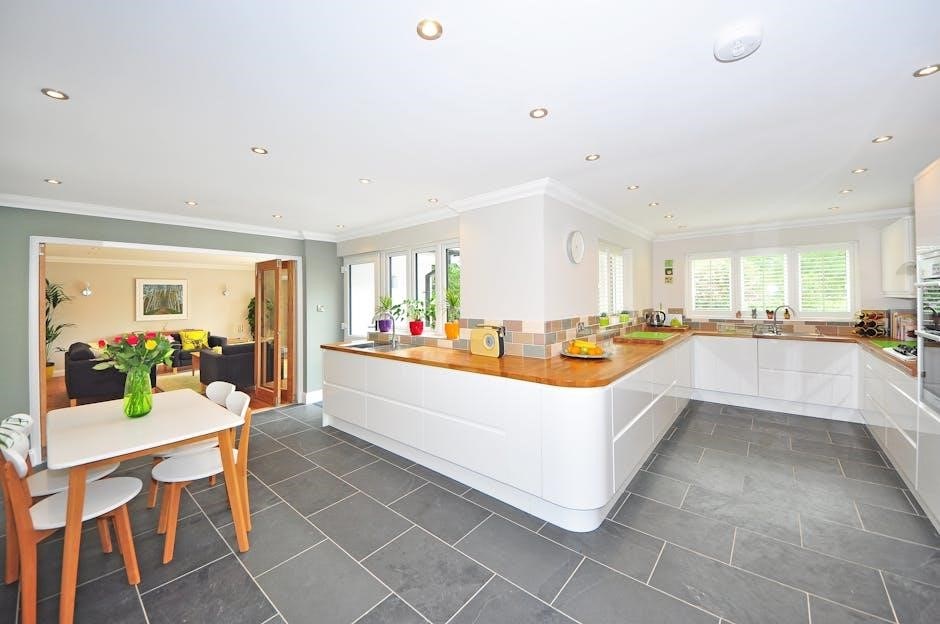Multifamily house plans are designed to accommodate multiple families or units in a single structure‚ offering space efficiency and modern amenities. These plans are ideal for maximizing property value and rental income‚ while providing comfortable living spaces for residents. They often include configurations like duplexes‚ triplexes‚ and larger multi-unit designs‚ tailored to meet the needs of various households and investors.
By incorporating scalable layouts and flexible design options‚ multifamily house plans cater to diverse needs‚ from small apartment buildings to larger developments. They emphasize functionality‚ comfort‚ and sustainability‚ making them a popular choice for urban and suburban areas alike.
1.1 Definition and Purpose
Multifamily house plans refer to architectural designs for buildings that accommodate multiple residential units under one roof. These plans are tailored to maximize space efficiency and cater to diverse housing needs‚ offering configurations like duplexes‚ triplexes‚ and larger multi-unit structures. Their purpose is to provide affordable‚ functional‚ and comfortable living spaces for multiple families or tenants‚ while also serving as investment opportunities for property owners. By designing units with shared walls or separate entrances‚ these plans aim to balance privacy and community living‚ making them ideal for urban and suburban areas.
Such designs are particularly popular among developers and investors seeking to maximize property value and rental income. They often include modern amenities and scalable layouts to meet various lifestyle demands‚ ensuring versatility and long-term appeal.
1.2 Importance of Multifamily Housing
Multifamily housing plays a crucial role in addressing urban housing demands‚ offering efficient land use and higher density living solutions. It provides affordable options for diverse demographics‚ including young professionals and growing families. These structures promote community living through shared spaces‚ fostering social connections and a sense of belonging. Additionally‚ multifamily housing is an attractive investment opportunity‚ yielding significant rental income and appreciating property values over time. Its adaptability accommodates various unit sizes and configurations‚ ensuring it meets the needs of different lifestyles and preferences‚ making it a vital component of modern urban development strategies.
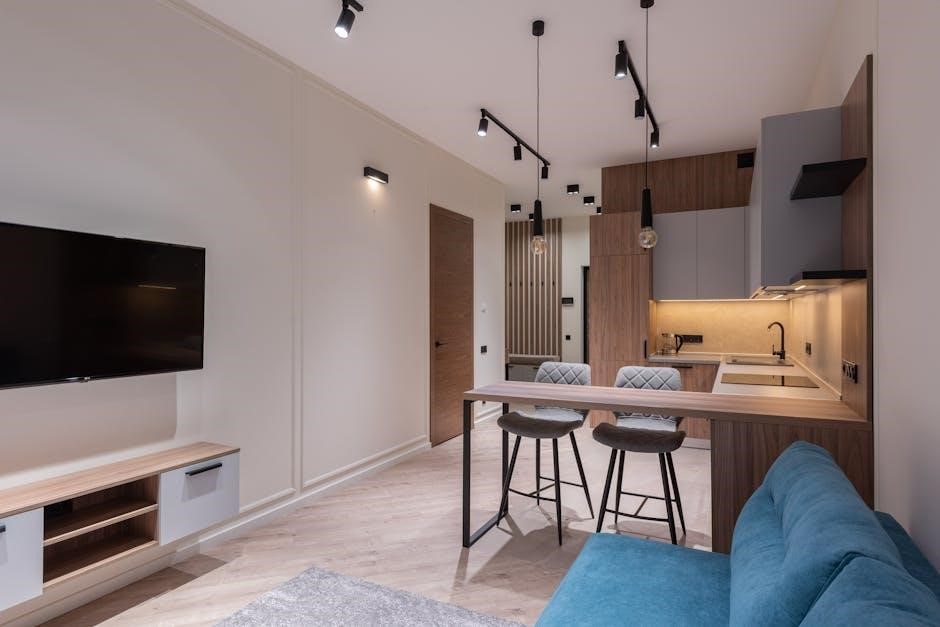
Types of Multifamily House Plans
Multifamily house plans include duplex‚ triplex‚ fourplex‚ and larger multi-unit designs‚ each offering shared walls‚ separate living areas‚ and efficient use of space. Modern amenities are often featured.
2.1 Duplex House Plans
Duplex house plans are a popular choice for multifamily housing‚ offering two separate living units under one roof. These plans often feature shared walls to maximize space efficiency. Modern duplex designs include amenities like cozy living areas‚ multiple bedrooms‚ and bathrooms‚ making them ideal for families or rental opportunities. Many duplex plans are available in farmhouse or Southern charm styles‚ blending functionality with aesthetic appeal. They typically range from 2‚400 to 2‚600 square feet‚ with two floors and a garage. Digital PDF downloads of these plans allow for easy access and customization‚ ensuring they meet specific needs while maintaining comfort and style.
2.2 Triplex House Plans
Tripex house plans are designed to accommodate three distinct living units‚ making them a versatile option for multifamily housing. These plans often feature separate units divided by floors‚ walls‚ or both‚ ensuring privacy for each household. They are ideal for small-scale developments or investors looking to maximize rental income. Triplex designs typically include modern amenities and efficient layouts‚ balancing comfort with practicality. Available as digital PDF downloads‚ these plans offer easy access and customization options. They are particularly suitable for urban or suburban areas where space is limited but demand for housing is high. Triplex plans provide a balanced solution for density and livability.
2.3 Fourplex and Larger Multi-Unit Plans
Fourplex and larger multi-unit plans are designed for accommodating four or more families in a single structure‚ offering a scalable solution for property developers and investors. These plans are ideal for maximizing space and rental income‚ often featuring multiple floors or adjacent units. They are well-suited for high-density urban areas where land is scarce. Available as downloadable PDFs‚ these plans provide detailed layouts and modern amenities‚ ensuring comfort and functionality for residents. Larger multi-unit designs also offer the potential for shared common spaces‚ enhancing community living while maintaining privacy. They are a practical choice for those seeking to create efficient and profitable housing developments.
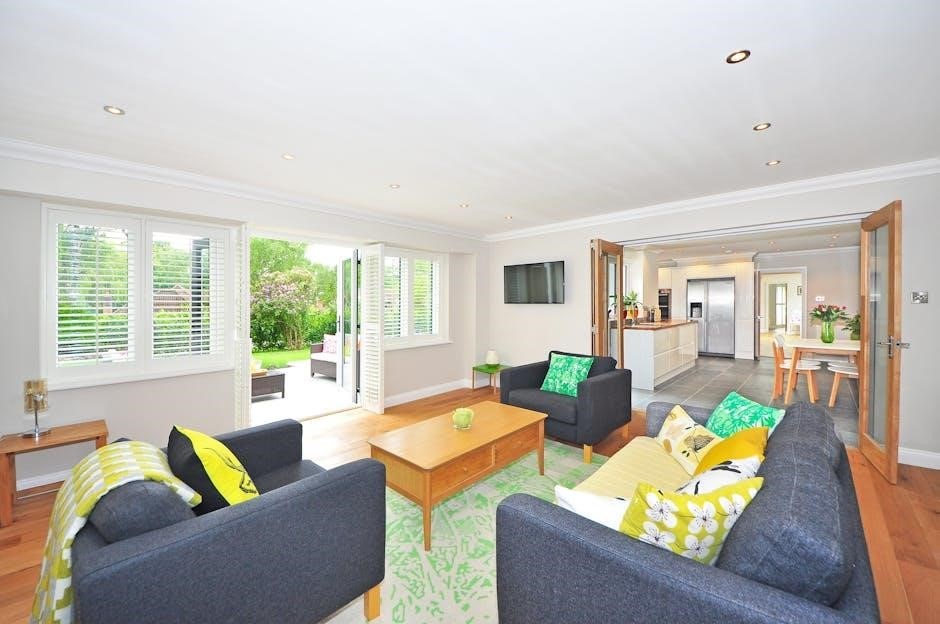
Key Features of Multifamily House Plans
Key features include space efficiency‚ ensuring optimal use of land and living areas. They incorporate modern amenities for comfort and convenience‚ such as shared facilities and sleek designs. Additionally‚ these plans offer scalability‚ allowing adaptation to various property sizes and tenant needs‚ making them versatile for different investment goals.
3.1 Space Efficiency and Layout
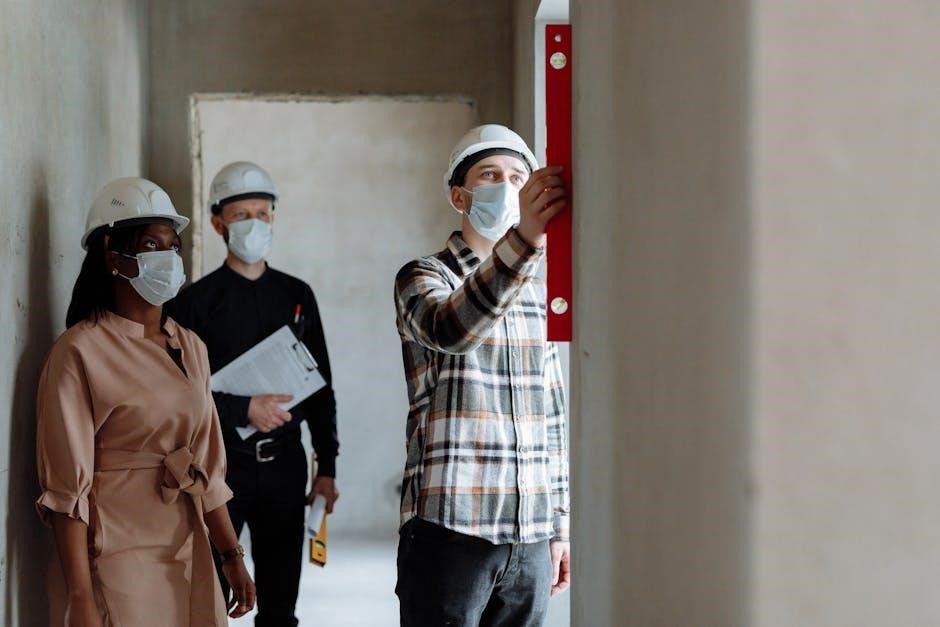
Multifamily house plans emphasize space efficiency to maximize occupancy while maintaining comfort. These designs often feature compact floor plans with clever use of vertical space‚ reducing waste and optimizing land use. Open-concept living areas and multi-functional rooms are common‚ allowing residents to enjoy functionality without sacrificing style. Additionally‚ these layouts are structured to minimize hallways and common areas‚ ensuring that the majority of the space is dedicated to livable areas. This approach not only enhances the overall property value but also appeals to tenants seeking practical and modern living solutions. Efficient layouts are particularly important in urban settings where land is scarce.
3;2 Modern Amenities and Comfort
Multifamily house plans often include modern amenities to enhance resident comfort and satisfaction. Features like energy-efficient appliances‚ spacious kitchens‚ and contemporary bathrooms are frequently incorporated. Many designs also offer in-unit laundry facilities and private outdoor spaces‚ such as balconies or patios‚ providing a sense of personal retreat. Additionally‚ amenities like shared community spaces‚ fitness centers‚ and secure parking are common in larger multifamily projects. These elements not only improve the quality of life for residents but also make the property more attractive to potential tenants or buyers. The integration of smart home technology and high-speed internet connectivity further elevates the living experience‚ catering to modern lifestyles and preferences.
3.3 Scalability for Different Needs
Multifamily house plans are designed to be scalable‚ accommodating a variety of needs and preferences. Whether it’s a duplex‚ triplex‚ or larger multi-unit structure‚ these plans can be adapted to suit different property sizes‚ budgets‚ and lifestyle requirements. Scalability allows developers to maximize space efficiency while offering flexibility in unit configurations. For instance‚ a duplex can be expanded into a triplex or fourplex‚ depending on the lot size and zoning regulations. This adaptability makes multifamily house plans ideal for both small-scale investors and large-scale developers. Additionally‚ scalability ensures that the design can evolve to meet changing demographics or market demands‚ providing long-term value and versatility.

Benefits of Multifamily House Plans
Multifamily house plans maximize property value‚ offer rental income opportunities‚ and foster community building. They provide space efficiency‚ modern amenities‚ and scalable designs to enhance living experiences for residents.
4;1 Maximizing Property Value
Multifamily house plans significantly enhance property value by optimizing land use and offering diverse housing options. These designs attract renters and buyers‚ increasing demand and potential income. With configurations like duplexes and triplexes‚ properties can accommodate multiple units‚ boosting ROI. Modern amenities and efficient layouts further elevate appeal‚ making multifamily homes desirable investments. Scalable designs allow customization to suit market trends‚ ensuring long-term value. By providing functional and stylish living spaces‚ multifamily house plans create vibrant communities‚ enhancing property value and fostering economic growth.
4.2 Rental Income Opportunities
Multifamily house plans offer substantial rental income opportunities by providing multiple units under one roof. Investors can maximize revenue through duplexes‚ triplexes‚ or larger complexes‚ appealing to a wide tenant base. These designs enable efficient property management and consistent cash flow‚ making them a smart investment choice. With modern amenities and functional layouts‚ multifamily homes attract renters seeking convenience and comfort‚ ensuring high occupancy rates and steady income streams.
By catering to diverse housing needs‚ multifamily plans create a reliable source of passive income. Their adaptability to various markets enhances their appeal‚ making them a lucrative option for landlords and property developers.
4.3 Community Building and Social Benefits
Multifamily house plans foster community building by bringing residents together in shared spaces‚ creating opportunities for social interaction and a sense of belonging. These designs often include communal areas like courtyards‚ gardens‚ or shared amenities‚ which encourage neighborly connections and collaboration. The proximity of multiple families in one structure promotes a vibrant‚ inclusive environment‚ making it easier for residents to form relationships and support networks. This sense of community is particularly valuable in urban areas‚ where isolation can be common‚ and in smaller towns‚ where close-knit neighborhoods are cherished. Multifamily housing thus serves as a catalyst for stronger‚ more connected communities.
By designing spaces that naturally bring people together‚ multifamily house plans contribute to social well-being and a stronger collective identity among residents.
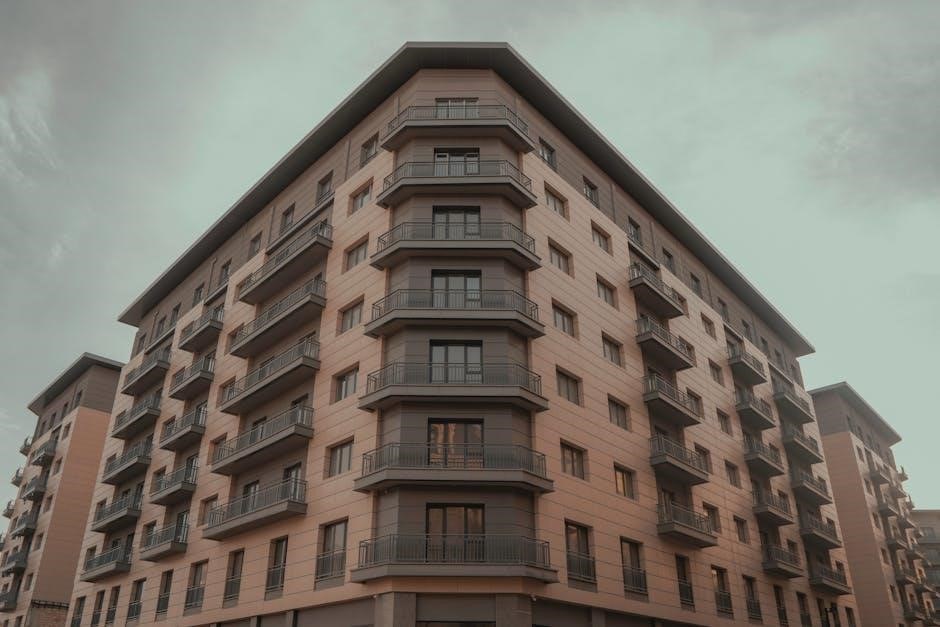
Design Considerations
Design considerations for multifamily house plans focus on optimizing space‚ ensuring functionality‚ and enhancing aesthetics while meeting zoning requirements and incorporating sustainable elements for modern living.
5.1 Balancing Privacy and Shared Spaces
Balancing privacy and shared spaces in multifamily house plans is crucial for fostering community while respecting individual needs. Open layouts in common areas‚ such as living rooms or kitchens‚ encourage social interaction‚ while private bedrooms and bathrooms ensure personal space. Strategic placement of walls and soundproofing materials helps minimize noise between units. Additionally‚ shared outdoor spaces like courtyards or balconies provide communal areas without compromising privacy. This balance is key to creating harmonious living environments that cater to both solitary and social preferences‚ enhancing overall resident satisfaction and property value.
5.2 Compliance with Local Zoning Laws
Compliance with local zoning laws is essential when designing multifamily house plans. These laws regulate land use‚ building height‚ unit density‚ and setbacks‚ ensuring projects align with community standards. Violating zoning laws can lead to legal issues‚ fines‚ or project delays. Architects and developers must thoroughly research and adhere to these regulations‚ which vary by location. For instance‚ some areas may restrict the number of units per lot or mandate specific design elements. Ensuring compliance early in the planning process helps avoid costly revisions or approvals. This step is critical for maintaining legal integrity and achieving successful project execution.
5.3 Incorporating Sustainable Design Elements
Incorporating sustainable design elements into multifamily house plans is crucial for environmental efficiency and long-term cost savings. Energy-efficient systems‚ such as solar panels and insulation‚ reduce energy consumption. Green building materials‚ like recycled steel and bamboo flooring‚ minimize environmental impact. Water conservation strategies‚ including low-flow fixtures and rainwater harvesting‚ are also key. Designers often integrate natural lighting and ventilation to reduce reliance on artificial systems. Additionally‚ renewable energy sources and smart home technologies can enhance sustainability. These elements not only benefit the environment but also attract eco-conscious tenants and investors‚ increasing property value and market appeal.
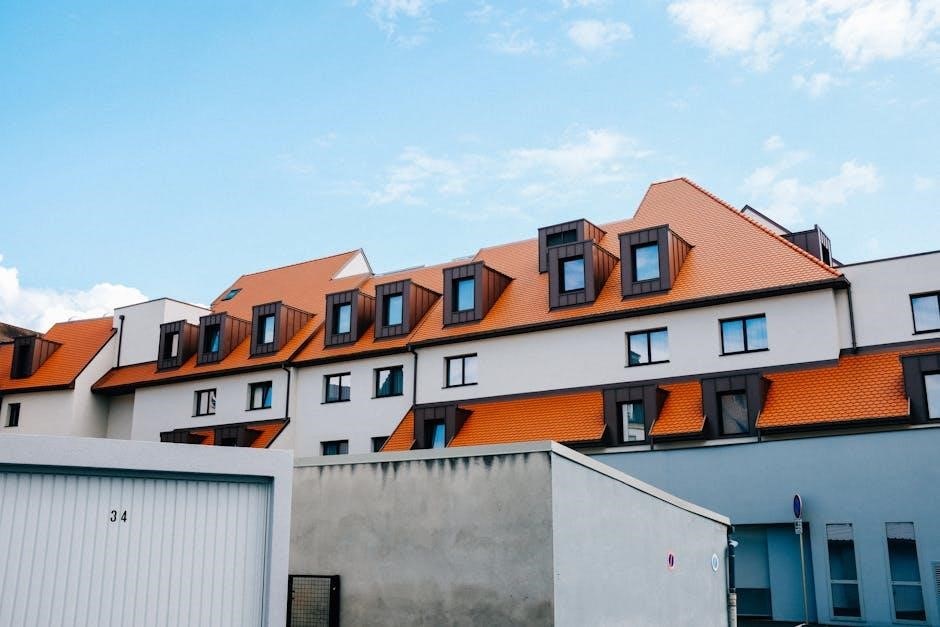
Where to Find Multifamily House Plans
Multifamily house plans are available on online architectural platforms‚ PDF repositories‚ and through professional architects. These sources offer customizable designs‚ ensuring efficient and stylish living solutions.
6.1 Online Architectural Platforms
Online architectural platforms are a primary source for multifamily house plans in PDF formats. These platforms offer a wide selection of designs‚ from duplexes to larger multi-unit structures‚ ensuring variety and adaptability. Users can explore customizable options to suit specific needs‚ enhancing functionality and aesthetics. Many platforms provide downloadable PDFs‚ allowing easy access and modifications. This accessibility makes it convenient for individuals and professionals to find and adapt plans efficiently. These resources are cost-effective and readily available‚ catering to different preferences and project requirements. They simplify the planning process‚ making multifamily housing designs more accessible than ever.
6.2 PDF Repositories and Downloads
PDF repositories offer a convenient way to access multifamily house plans‚ providing instant downloads for various designs. These repositories feature a wide range of layouts‚ from duplexes to larger multi-unit structures‚ ensuring versatility for different projects. Many platforms allow users to purchase and download PDF files directly‚ enabling easy access to detailed floor plans‚ elevations‚ and construction documents. This option is particularly useful for architects‚ developers‚ and homeowners seeking customizable solutions. Additionally‚ some repositories provide options for modifying plans to suit specific needs‚ making them a practical choice for those looking to tailor designs while maintaining cost efficiency and convenience.
6.3 Consulting Professional Architects
Consulting professional architects is a crucial step in developing multifamily house plans‚ especially when seeking customized solutions. Architects bring expertise in creating functional and aesthetically pleasing designs tailored to specific requirements. They can transform PDF templates into personalized layouts‚ ensuring compliance with local building codes and zoning laws. By collaborating with architects‚ clients can integrate sustainable elements and modern amenities‚ enhancing both livability and property value. This approach also allows for modifications to existing PDF plans‚ ensuring the final design meets the unique needs of the project. Professional architects provide invaluable guidance‚ from conceptualization to execution‚ making them an essential resource for successful multifamily developments.
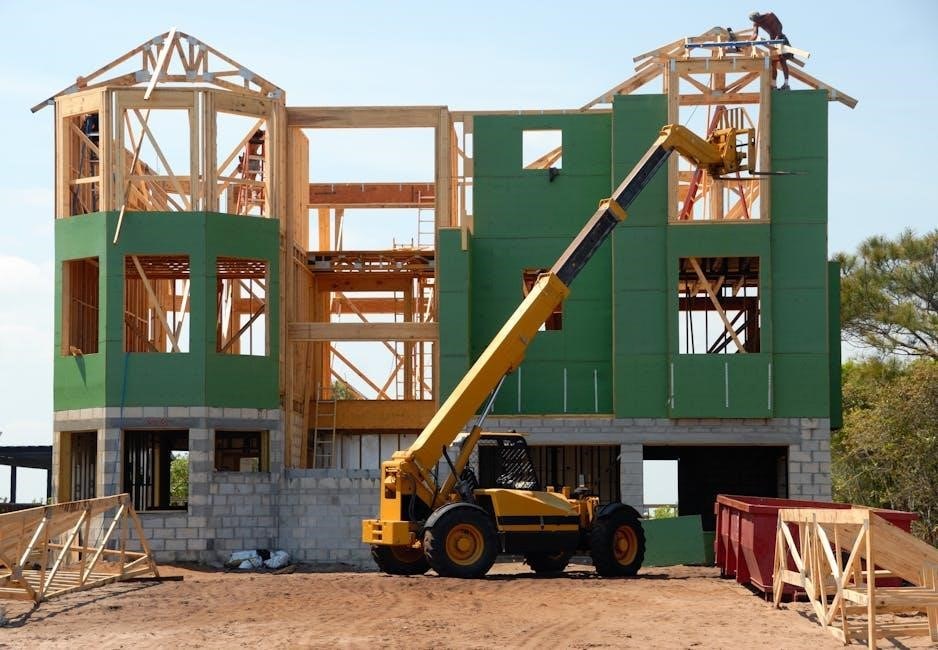
Customization Options
Multifamily house plans can be tailored to meet specific needs‚ including modifications to floor layouts‚ additions of unique design elements‚ and adjustments for energy efficiency or aesthetic preferences.
7.1 Tailoring Floor Plans to Specific Needs
Tailoring floor plans to specific needs allows for personalized living spaces within multifamily structures. Homeowners and investors can modify layouts to optimize functionality‚ ensuring each unit meets unique requirements. This customization enhances comfort and usability‚ making the property more appealing. Whether it’s adjusting room sizes‚ reconfiguring kitchen layouts‚ or incorporating storage solutions‚ tailored floor plans ensure that the design aligns with the lifestyles of the residents. Such flexibility is crucial for maximizing space efficiency and creating a sense of home within a shared building. This approach also boosts property value and tenant satisfaction‚ making it a key aspect of multifamily housing design.
7.2 Adding Unique Design Elements
Adding unique design elements to multifamily house plans enhances both functionality and aesthetics‚ making each unit stand out. Incorporating features like exposed beams‚ vaulted ceilings‚ or custom cabinetry can create a distinctive character. Modern amenities such as smart home technology or energy-efficient systems also add value. These elements not only improve livability but also appeal to potential renters or buyers. By integrating personalized touches‚ multifamily designs can reflect the preferences of residents while maintaining a cohesive overall structure. This approach ensures that each unit feels like a home‚ even within a shared building‚ boosting both satisfaction and property appeal.
7.3 Modifications for Energy Efficiency
Modifying multifamily house plans for energy efficiency involves incorporating eco-friendly features that reduce energy consumption and costs. Updating HVAC systems‚ improving insulation‚ and installing energy-efficient windows are common modifications. Adding solar panels or rainwater harvesting systems can further enhance sustainability. Design elements like larger south-facing windows for natural light and passive solar heating are also effective. These modifications not only lower utility bills but also contribute to a smaller environmental footprint. By integrating smart home technology‚ residents can monitor and manage energy usage more effectively. Such changes make multifamily housing more appealing to environmentally conscious renters and investors‚ offering long-term benefits.
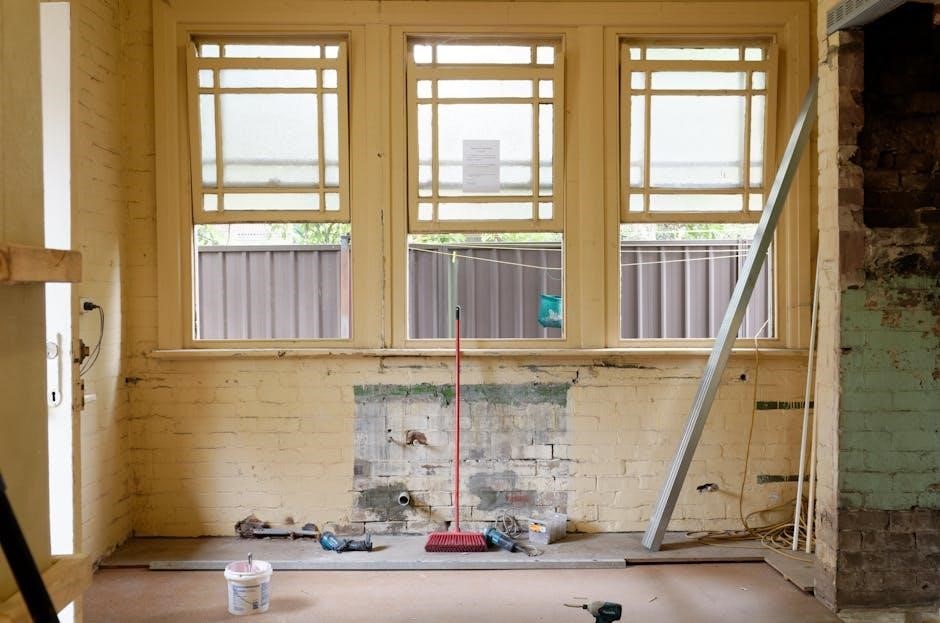
Legal and Regulatory Aspects
Understanding legal and regulatory aspects is crucial for multifamily house plans. Compliance with zoning laws‚ building codes‚ and safety standards ensures projects meet local requirements and avoid penalties.
Obtaining necessary permits and approvals is essential. This process involves submitting detailed plans and adhering to inspections‚ ensuring all legal and regulatory obligations are fulfilled.
8.1 Zoning Laws and Restrictions
Zoning laws and restrictions play a pivotal role in shaping multifamily house plans. These regulations dictate the type of constructions allowed in specific areas‚ ensuring compatibility with neighborhood character and safety standards. For instance‚ zoning laws may specify height limits‚ parking requirements‚ and density constraints‚ directly influencing the design and layout of multifamily units. Compliance with these laws is non-negotiable‚ as violations can lead to project rejection or hefty fines. Understanding local zoning ordinances is essential for developers and architects to create plans that align with community guidelines while maximizing property value and rental income potential.
Failure to adhere to zoning laws can result in legal setbacks‚ making it crucial to consult local authorities before finalizing any multifamily house plan.
8.2 Building Codes and Safety Standards
Building codes and safety standards are critical in multifamily house plans to ensure the well-being of occupants and the structural integrity of the property. These codes outline requirements for fire resistance‚ emergency exits‚ and accessibility‚ ensuring compliance with local and national regulations. Architects and developers must adhere to these standards to create safe living environments‚ protect investments‚ and avoid legal penalties. Non-compliance can lead to severe consequences‚ including project rejection or safety hazards. By integrating these standards‚ multifamily house plans not only meet legal requirements but also provide peace of mind for residents and owners alike.
Regular inspections and certifications are often required to verify compliance with these essential safety measures.
8.4 Navigating Permits and Approvals
Navigating permits and approvals for multifamily house plans requires a thorough understanding of local regulations and submission processes. Builders must obtain necessary permits before construction begins‚ ensuring compliance with zoning laws and safety standards. Delays often occur due to incomplete or incorrect applications‚ emphasizing the importance of detailed preparation. Working closely with local authorities and professionals can streamline the process. Many resources‚ including PDF guides‚ provide step-by-step instructions to help applicants avoid common pitfalls. Proper documentation and timely submissions are crucial to securing approvals efficiently‚ minimizing delays‚ and ensuring the project stays on track.
Failure to comply can result in costly fines or project halts.
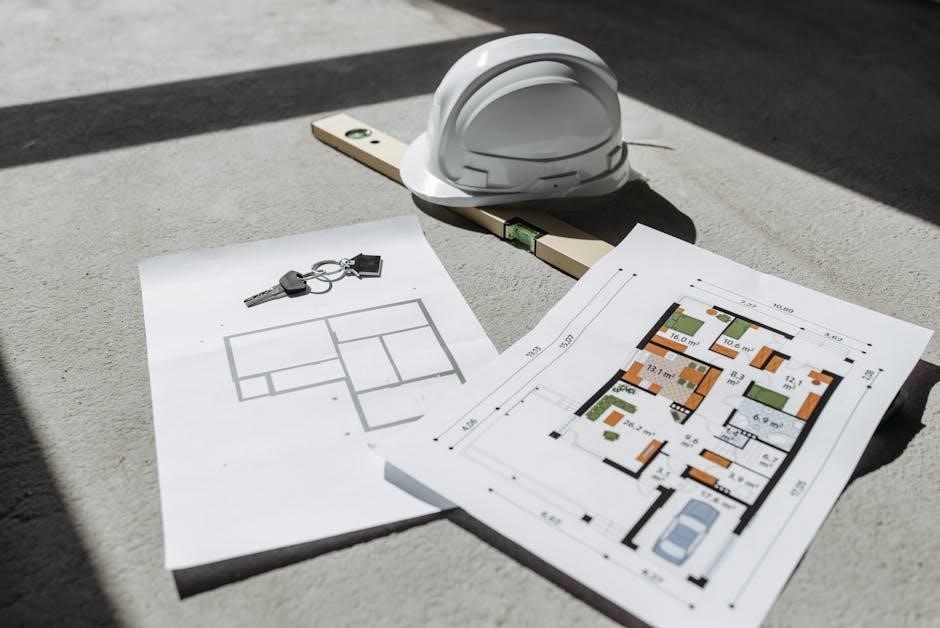
Sustainability in Multifamily Housing
Multifamily housing emphasizes energy-efficient designs‚ green materials‚ and water-saving strategies. These eco-friendly approaches reduce environmental impact while lowering utility costs‚ enhancing occupant comfort and property value.
By incorporating solar panels‚ insulation‚ and recycled materials‚ sustainable multifamily plans promote long-term environmental benefits and support modern eco-conscious living standards.
9.1 Energy-Efficient Design
Energy-efficient design is a cornerstone of sustainable multifamily housing. By integrating features like high-performance insulation‚ double-pane windows‚ and solar panel installations‚ these plans significantly reduce energy consumption.
Modern layouts often prioritize natural light and airflow‚ minimizing the need for artificial lighting and heating. Smart home technologies‚ such as programmable thermostats‚ further optimize energy use. These strategies not only lower utility costs but also contribute to a reduced carbon footprint‚ aligning with global sustainability goals.
Energy-efficient designs in multifamily plans ensure long-term cost savings and environmental benefits‚ making them appealing to eco-conscious investors and residents alike.
9.2 Green Building Materials
Green building materials are essential for creating eco-friendly multifamily housing. Sustainable options like reclaimed wood‚ bamboo flooring‚ and low-VOC paints reduce environmental impact.
Recycled steel and insulated concrete forms are durable choices that enhance energy efficiency. These materials not only minimize waste but also offer long-term cost savings through reduced maintenance.
Builders often incorporate materials with high recycled content‚ ensuring compliance with environmental standards like LEED certification. Using green materials promotes healthier living spaces and supports global sustainability efforts‚ making them a key component of modern multifamily designs.
9.3 Water Conservation Strategies
Water conservation strategies are crucial for sustainable multifamily housing. These strategies include installing low-flow fixtures like toilets‚ showerheads‚ and faucets to reduce water usage.
- Greywater recycling systems reuse water from sinks and washing machines for irrigation.
- Rainwater harvesting collects and stores rain for landscaping and non-potable needs.
- Efficient irrigation systems minimize water waste in common areas.
These methods not only lower utility costs but also reduce the environmental impact of multifamily developments‚ promoting eco-friendly living and long-term sustainability.
Multifamily house plans offer a practical and efficient solution for modern living‚ combining space optimization with amenities. They provide opportunities for rental income and sustainable housing solutions.
These plans are ideal for investors and families seeking versatile‚ cost-effective‚ and eco-friendly living spaces‚ making them a cornerstone of future housing developments.
10.1 Summary of Key Points
Multifamily house plans offer efficient and modern living solutions‚ catering to diverse needs through various configurations like duplexes‚ triplexes‚ and larger multi-unit designs. These plans emphasize space optimization‚ comfort‚ and sustainability‚ making them ideal for both urban and suburban settings. They provide opportunities for rental income and property value appreciation while fostering community living. With options for customization and energy efficiency‚ multifamily house plans are versatile and adaptable‚ ensuring they meet the demands of contemporary housing. Their availability in PDF formats simplifies access and implementation‚ making them a practical choice for developers and homeowners alike.
10.2 Final Thoughts on Multifamily House Plans
Multifamily house plans represent a practical and efficient solution for modern living‚ offering a balance of comfort‚ functionality‚ and sustainability. Whether for investment‚ rental income‚ or community building‚ these designs cater to diverse needs. Their versatility allows for customization‚ ensuring they adapt to various lifestyles and preferences. With the convenience of PDF downloads‚ accessing and implementing these plans has never been easier. As urbanization grows‚ multifamily house plans continue to play a vital role in addressing housing demands while promoting eco-friendly and socially beneficial living environments. They remain a cornerstone of contemporary architecture‚ blending practicality with innovative design.
